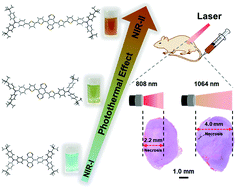Molecular engineering of D–A–D conjugated small molecule nanoparticles for high performance NIR-II photothermal therapy†
Abstract
Chemically defined conjugated small molecules (CSMs) and their nanoparticles (CSMNs) have been widely used in phototheranostics. However, CSMNs have rarely been studied for second near-infrared (NIR-II) deep-tissue photothermal therapy (PTT) due to the lack of NIR-II-absorbing CSMNs. Herein, through a molecular engineering strategy of “increasing the number of thiophene bridges”, three donor–acceptor–donor (D–A–D) CSMs, namely CSM0-2 in which the number represents the number of thiophene bridges, have been synthesized. The optical bandgap decreases with the increase of the number of thiophene bridges. Among them, CSM2 has strong absorption in both the first near-infrared (NIR-I) and NIR-II regions. CSMN2 exhibits high photothermal conversion efficiency (PTCE = 31.6%) in NIR-II and excellent biocompatibility. By using CSMN2, photoacoustic imaging (PAI)-guided in vivo tumor NIR-II PTT is achieved under low laser power density (0.5 W cm−2). The molecular engineering strategy reported here can potentially be applied to other D–A systems for the development of new materials in phototheranostics.

- This article is part of the themed collection: Materials Horizons Lunar New Year collection 2021


 Please wait while we load your content...
Please wait while we load your content...